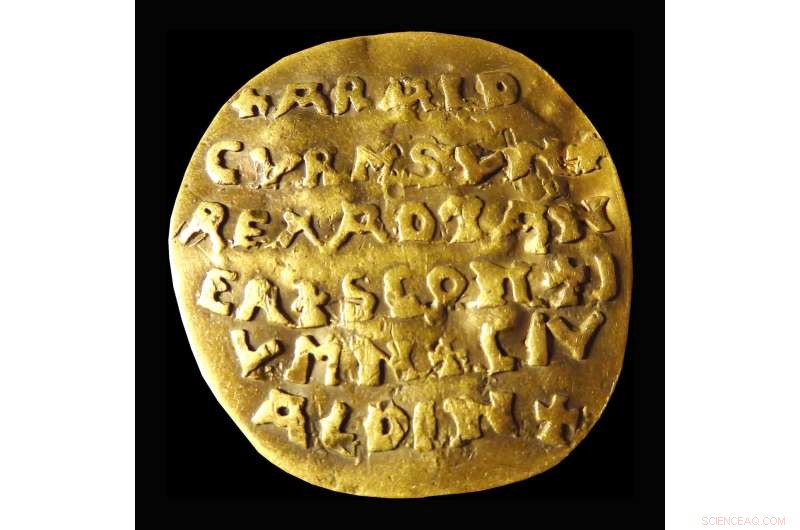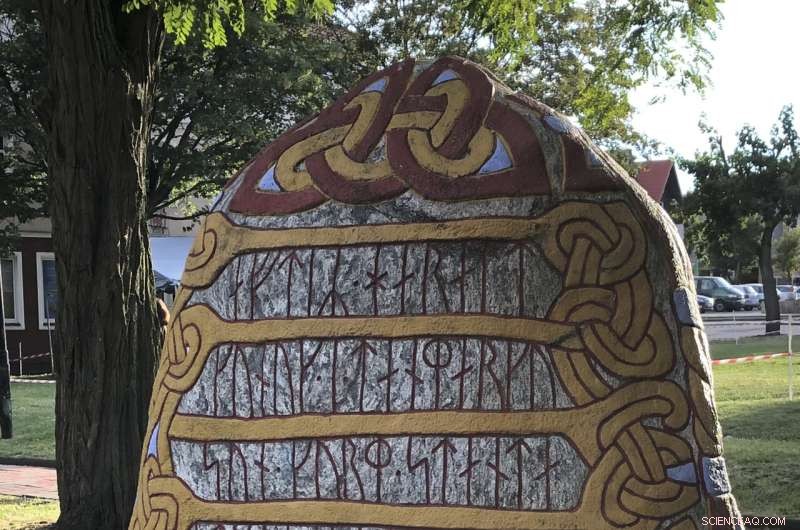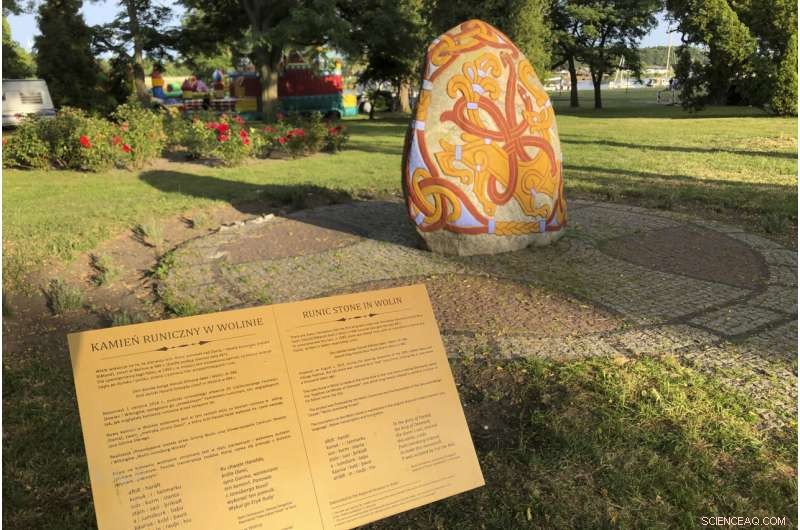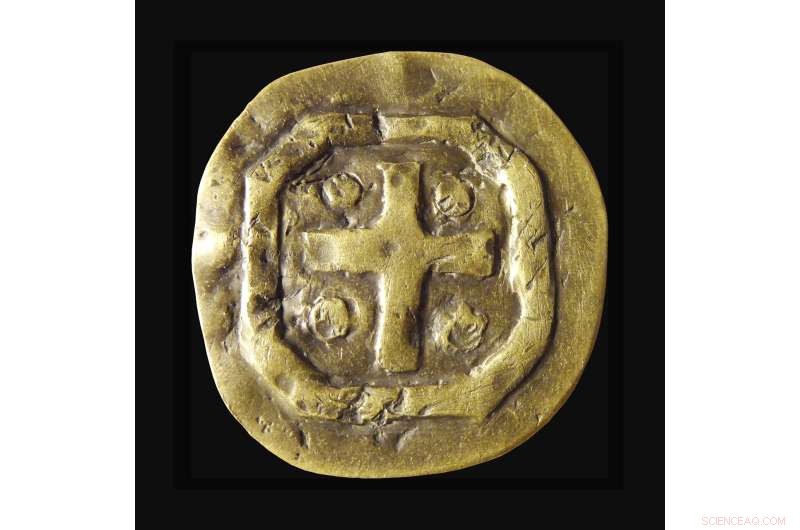
El disco dorado Curmsun del siglo X con el nombre del rey danés Harald "Bluetooth" Gormsson (Curmsun en latín), procedente de una tumba en la iglesia católica romana en Wiejkowo, Polonia, fotografiado en Malmo, Suecia, en 2015. El Bluetooth La tecnología de enlace inalámbrico lleva el nombre del rey. Más de 1.000 años después de su muerte en lo que ahora es Polonia, un rey danés cuyo apodo es conocido en todo el mundo a través de la tecnología Bluetooth se encuentra en el centro de una disputa arqueológica. Crédito:Sven Rosborn vía AP
Más de 1000 años después de su muerte en lo que ahora es Polonia, un rey europeo cuyo apodo perdura gracias a la tecnología inalámbrica se encuentra en el centro de una disputa arqueológica.
Las crónicas de la Edad Media dicen que el rey Harald "Bluetooth" Gormsson de Dinamarca adquirió su apodo por cortesía de un diente, probablemente muerto, que parecía azulado. Una crónica de la época también dice que el rey vikingo fue enterrado en Roskilde, en Dinamarca, a finales del siglo X.
Pero un arqueólogo sueco y un investigador polaco afirmaron recientemente en publicaciones separadas que habían identificado su sitio de entierro más probable en el pueblo de Wiejkowo, en un área del noroeste de Polonia que tenía vínculos con los vikingos en la época de Harald.
Marek Kryda, autor del libro "Polonia vikinga", dijo a The Associated Press que un "montículo pagano" que afirma haber ubicado debajo de la iglesia católica romana del siglo XIX de Wiejkowo probablemente contiene los restos del rey. Kryda dijo que las imágenes geológicas satelitales disponibles en un portal del gobierno polaco revelaron una forma rotunda que parecía un túmulo funerario vikingo.
Pero el arqueólogo sueco Sven Rosborn dice que Kryda está equivocado porque Harald, quien se convirtió del paganismo al cristianismo y fundó iglesias en el área, debe haber recibido una tumba apropiada en algún lugar del cementerio. La Iglesia de la Inmaculada Concepción de la Santísima Virgen María de Wiejkowo se encuentra en lo alto de una pequeña loma redonda.

Una vista de una piedra de 2014 con inscripción rúnica en memoria del rey danés del siglo X Harald "Bluetooth" Gormsson, en Wolin, Polonia, el sábado 30 de julio de 2022. Más de 1.000 años después de su muerte en lo que ahora es Polonia, un rey danés cuyo apodo es conocido en todo el mundo a través de la tecnología Bluetooth se encuentra en el centro de una disputa arqueológica. Un investigador polaco y un arqueólogo sueco afirman que han identificado el probable lugar de enterramiento del rey Harald Bluetooth Gormsson en un pequeño pueblo en el noroeste de Polonia, un área que una vez tuvo vínculos con los vikingos. Crédito:Foto AP Monika Scislowska
Los historiadores del Museo Nacional Danés en Copenhague dicen que están familiarizados con la "sugerencia" de que Wiejkowo es el lugar de enterramiento de Harald.
Rosborn detalló su investigación en el libro de 2021 "El tesoro dorado del rey vikingo" y Kryda cuestionó algunos de los hallazgos del sueco en su propio libro publicado este año.
Harald, who died in 985, probably in Jomsborg—which is believed to be the Polish town of Wolin now—was one of the last Viking kings to rule over what is now Denmark, northern Germany, and parts of Sweden and Norway. He spread Christianity in his kingdom.
Swedish telecommunications company Ericsson named its Bluetooth wireless link technology after the king, reflecting how he united much of Scandinavia during his lifetime. The logo for the technology is designed from the Scandinavian runic letters for the king's initials, HB.

A view of a 2014 stone with runic inscription in memory of Danish 10th century King Harald “Bluetooth” Gormsson, in Wolin, Poland, Saturday, July 30,2022. More than 1,000 years after his death in what is now Poland, a Danish king whose nickname is known to the world through the Bluetooth technology is at the center of an archeological dispute. A Polish researcher and a Swedish archeologist claim that they have pinpointed the probable burial site for King Harald Bluetooth Gormsson in a small village in northwestern Poland, an area that once had ties with the Vikings. Credit:AP Photo Monika Scislowska
Rosborn, the former director of Sweden's Malmo City Museum, was spurred on his quest in 2014 when an 11-year-old girl sought his opinion about a small, soiled coin-like object with old-looking text that had been in her family's possession for decades.
Experts have determined that the cast gold disk that sparked Maja Sielski's curiosity dated from the 10th century. The Latin inscription on what is now known as the "Curmsun disk" says:"Harald Gormsson (Curmsun in Latin) king of Danes, Scania, Jomsborg, town Aldinburg."
Sielski's family, who moved to Sweden from Poland in 1986, said the disk came from a trove found in 1841 in a tomb underneath the Wiejkowo church, which replaced a medieval chapel.
The Sielski family came into the possession of the disk, along with the Wiejkowo parish archives that contained medieval parchment chronicles in Latin, in 1945 as the former German area was becoming part of Poland as a result of World War II.

The Roman Catholic church where it is believed that Danish King Harald Gormsson was buried, in Wiejkowo, Poland, Saturday, July 30, 2022. More than 1,000 years after his death in what is now Poland, a Danish king whose nickname is known to the world through the Bluetooth technology is at the center of an archeological dispute. A Polish researcher and a Swedish archeologist claim that they have pinpointed the probable burial site for King Harald Bluetooth Gormsson in a small village in northwestern Poland, an area that once had ties with the Vikings. Credit:AP Photo Monika Scislowska

A view inside the Roman Catholic church where it is believed that Danish King Harald Gormsson was buried, in Wiejkowo, Poland, Saturday, July 30, 2022. More than 1,000 years after his death in what is now Poland, a Danish king whose nickname is known to the world through the Bluetooth technology is at the center of an archeological dispute. A Polish researcher and a Swedish archeologist claim that they have pinpointed the probable burial site for King Harald Bluetooth Gormsson in a small village in northwestern Poland, an area that once had ties with the Vikings. Credit:AP Photo Monika Scislowska

The 10th century golden Curmsun disc with the name of Danish King Harald “Bluetooth“ Gormsson (Curmsun in Latin) on it, coming from a tomb at the Roman Catholic church in Wiejkowo, Poland, photographed in Malmo, Sweden, in 2015. The Bluetooth wireless link technology is named after the king. More than 1,000 years after his death in what is now Poland, a Danish king whose nickname is known to the world through the Bluetooth technology is at the center of an archeological dispute. Credit:Sven Rosborn via AP
A family member who knew Latin understood the value of the chronicles—which dated as far back as the 10th century—and translated some of them into Polish. They mention Harald, another fact linking the Wiejkowo church to him.
The nearby Baltic Sea island and town of Wolin cultivates the region's Viking history:it has a runic stone in honor of Harald Bluetooth and holds annual festivals of Slavs and Vikings.
Kryda says the Curmsun disk is "phenomenal" with its meaningful inscription and insists that it would be worth it to examine Wiejkowo as Harald's burial place, but there are no current plans for any excavations.
© 2022 Prensa Asociada. Reservados todos los derechos. Este material no se puede publicar, transmitir, reescribir ni redistribuir sin permiso. Archaeologists find silver treasure on German Baltic island